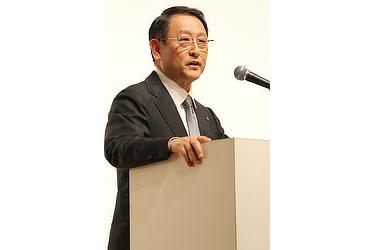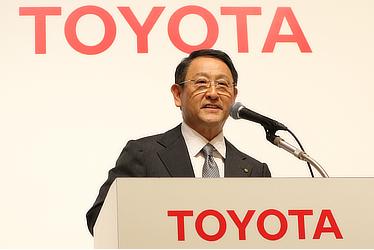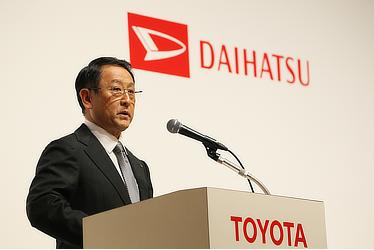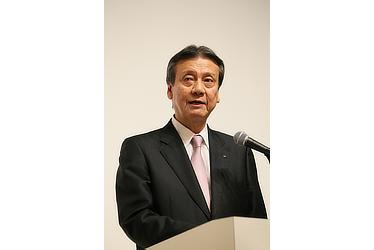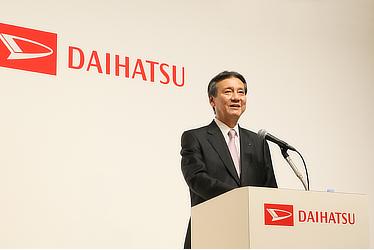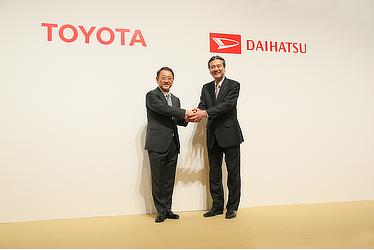Jan. 29, 2016
Daihatsu Motor Co., Ltd.
Toyota and Daihatsu to Strengthen Small Car Operations
through Unified Global Strategy
Toyota Motor Corporation (Toyota) and its subsidiary Daihatsu Motor Co., Ltd. (Daihatsu) have reached an agreement whereby Daihatsu will become a wholly-owned subsidiary of Toyota by way of a share exchange (expected to be completed in August 2016).
The purpose of the agreement is to develop of ever-better cars by adopting a unified strategy for the small car segment, under which both companies will be free to focus on their core competencies. Ultimately, this will help Daihatsu and Toyota to attain their joint goal of achieving sustainable growth.
Additionally, the aim of the share exchange is to enhance the value of both brands. Although Toyota and Daihatsu will engage in friendly competition and maintain separate management styles that capitalize on their respective capabilities, bringing the two together under a shared strategy will enable them to jointly overcome otherwise prohibitive obstacles in the future, including resource-intensive undertakings such as the development of next-generation technologies and entry into business areas with growth potential.
Explaining the decision, Toyota President Akio Toyoda said, "This is an opportunity for us both to stop feeling that we need to go it alone, and trust each other to take full advantage of our respective strengths. In other words, we can now focus on our core competencies. That, I believe, is the key to achieving and sustaining global competitiveness."
Daihatsu President Masanori Mitsui commented, "I believe we have now found a course of action that will enable us to continue our growth for the next 100 years. We see this as the perfect opportunity to cement our relationship with Toyota, and, by doing so, to embark on a new period of growth, and to elevate the Daihatsu brand to a global standard."
Objective
Areas of strategic collaboration
- Small cars
The differentiation between Toyota's and Daihatsu's brands will continue, and the product lineups of both will be optimized in accordance with customer preferences, with Daihatsu taking the lead in developing products offered within the small car lineups of both brands. At the same time, Daihatsu will continue to focus on developing vehicles aimed specifically at customers in the areas in which the brand already has a strong presence, while also honing its expertise and processes related to product planning and technological development for minivehicles.
- Technology
Both companies will share development and deployment strategies for new technologies from the initial conceptual stages. Toyota's focus will remain on technologies related to the environment, safety, user experience, and comfort, while Daihatsu will continue to leverage its aptitude for turning technologies into packages for vehicles, as well as developing cost- and fuel-efficient technologies. Daihatsu will also contribute to the development of next-generation technologies from the perspective of cost-efficiency and miniaturization. The company's specialized car manufacturing expertise will be shared within the Toyota Group, which will contribute to further enhancing the cost competitiveness of larger vehicles.
- Operations
Both companies will utilize each other's bases of operations in emerging markets. Daihatsu will take the lead in enhancing efficiency and adaptability in development, procurement, and production processes.
Outline of the share exchange
- Timeline of the Share Exchange
| Resolution of the board of directors regarding the execution of the Share Exchange Agreement (Both companies) | January 29, 2016 |
|---|---|
| Execution of the Share Exchange Agreement (Both companies) | January 29, 2016 |
| Record date for the annual general meeting of shareholders to approve the Share Exchange (Daihatsu) | March 31, 2016 |
| Annual general meeting of shareholders to approve the execution of the Share Exchange Agreement (Daihatsu) | End of June |
| Last day of trading (Daihatsu) | July 26, 2016 (planned) |
| Delisting (Daihatsu) | July 27, 2016 (planned) |
| Scheduled date of consummation of the Share Exchange (effective date) | August 1, 2016 |
- Notes
-
- Toyota will consummate the Share Exchange by means of a "simple share exchange" under Article 796, Paragraph 2 of the Companies Act, which does not require approval by shareholders at a shareholders' meeting.
- The expected date of consummation of the Share Exchange (effective date) is subject to change by mutual agreement between Toyota and Daihatsu.
- Details of Allotment in the Share Exchange
| Toyota (100% Parent Company) |
Daihatsu (Wholly-owned subsidiary) |
|
|---|---|---|
| Allotment ratio for the Share Exchange | 1 | 0.26 |
| Number of shares to be delivered in the Share Exchange | Common Stock54,035,654 shares (expected) | |
- Note
- 0.26 shares of common stock of Toyota will be allotted and delivered for each share of common stock of Daihatsu.
Good evening, and thank you all very much for attending our press conference at such short notice. I'm very sorry for any inconvenience the timing of this event may have caused.
I'd like to tell you about the reasoning that led us to make this decision.
Toyota and Daihatsu have frequently held discussions and shared opinions on the topic of sustainable growth. Last autumn, we told Daihatsu that we wanted to strengthen the relationship between our two companies in order to enable us both to make ever-better cars. President Mitsui from Daihatsu might have been a bit taken aback at first, but―as we kept talking―he told me that he hoped to maintain Daihatsu's unique approach to manufacturing, but that, on the other hand, the company's resources would limit his ability to expand the scope of the business, embrace the next wave of technologies, and improve competitiveness.
Daihatsu is a company whose independence and self-support I have always respected, and it was clear to me that President Mitsui's priority―as a leader―was to achieve global competitiveness no matter what, and to make sure that his company can grow sustainably.
I believe that President Mitsui made this decision out of consideration for all of Daihatsu's stakeholders, including employees, suppliers, dealers, customers, and investors.
It's a decision he made for the sake of the future of Daihatsu. As someone who has spent his entire career with Daihatsu, he has given everything to the company, and no-one embodies its values better than him. As a fellow leader, that means a great deal to me.
I honestly believe that maintaining what President Mitsui calls "Daihatsu's unique approach to manufacturing" is of the utmost importance to the entire Toyota Group as we continue with our efforts to make ever-better cars.
My experience with Toyota and Lexus has given me the firm belief that brands are built on trust, which has to be earned. Good brands take time to cultivate, which is why the brands that stick in your mind are the ones with heritage and stories.
Daihatsu has been doing business for 109 years. I believe that I understand and appreciate the value of their brand as well as anyone possibly can. The Daihatsu brand will have a key position, equal to that of Toyota and Lexus, in our efforts to make ever-better cars.
Of course, we at Toyota also have plenty of issues that we must overcome in order to achieve sustainable growth.
Implementing the Toyota New Global Architecture has once again made us aware of the difficulties involved in manufacturing small cars. At the same time, the importance of small cars is increasing as we face ever-greater environmental issues the world over, and as emerging markets continue their inevitable growth.
There are many things we have chosen to focus on as a company: in certain regions like North America, our strength lies in the mid-sized sedan segment and above. More generally, we have a good track record in our development of technologies―particularly environmental technologies.
However, I have frequently worried that we haven't managed to make our presence felt in the small car segment. Unless we gain the know-how necessary to better develop small cars, we may deprive ourselves of the chance to make crucial breakthroughs.
Furthermore, Daihatsu has the benefit of a spontaneous and independent nature. It's the best kind of honest, unpretentious company, with a culture of being down to Earth and respecting the work done on the front lines. I believe they may be in possession of something that Toyota has lost sight of.
I truly feel that we have a lot to learn from them.
We at Toyota are fixated on the need to be able to cover all of our own bases; you might say we are obsessed with self-sufficiency.
So, on one hand, while we have a long and credible history of producing small vehicles ourselves, on the other hand, our desire to go it alone has prevented us from achieving our full potential in terms of global competitiveness. Naturally, this decision was a difficult one to make.
In the end, the only reason we could make such a monumental decision was because we are talking about entrusting part of that obsession to none other than Daihatsu.
Toyota and Daihatsu first began to collaborate in 1967. Over a period of almost 50 years, our two companies have walked hand in hand, growing alongside one another while respecting each other's independence and competing on a friendly basis. This is the essence of collaboration in the Toyota Group, and we are able to entrust this much of our small car business to Daihatsu because they have stood beside us for such a long time.
Daihatsu excels at the kind of engineering that is needed in order to make affordable and high-quality products, and the company has thrived in the fiercely competitive and restrictive minivehicle segment. Going forward, small cars will continue to be the source of Daihatsu's competitiveness.
This is an opportunity for us both to stop feeling that we need to go it alone, and trust each other to take full advantage of our respective strengths. In other words, we can now focus on our core competencies. That, I believe, is the key to achieving and sustaining global competitiveness.
This is the kind of thing I have in mind when I talk about achieving sustainable growth through true competitiveness, and about making ever-better cars.
I would now like to pass the baton to Daihatsu President Masanori Mitsui, who has been, and will continue to be, our partner as Toyota, Daihatsu, and our entire Group join together in forging a path toward the future.
Good evening everyone. I would also like to express my thanks to all of you for attending tonight, despite being given so little notice. It's good to see so many of you here.
As you all know, we at Daihatsu have focused on a business model specializing around small cars―primarily in what is known here as the minivehicle segment.
In recent years, we have developed models such as the Mira e:S, which combines an affordable pricetag and excellent fuel economy, the Tanto and Hijet, which were created through concerted efforts to offer the features and performance sought by our customers, and the Ayla for Indonesia and Axia for Malaysia, which, like our Japan-market models, represent our dedication to meeting the needs and preferences of local customers.
Through the development of these vehicles, we have aimed to become the manufacturer closest to the consumer.
At the same time, I believe that we have succeeded with all of our efforts to hone and improve the unique manufacturing processes that small cars require.
From Daihatsu Motor Kyushu's Oita 2nd Plant, which was the first to adopt the concept of "Simple, Slim, Compact," to our plants in Indonesia and Malaysia that have become highly competitive thanks to the steps we have taken to be the very best in those countries, we have achieved a great deal.
We also have a long history of joing projects with Toyota, including production under contract since the 1960s, joint development since 2004, and provision of vehicles on an OEM basis. We have always used these projects as the most appropriate means of addressing our respective needs at the time.
Recently, we have been working to develop the ability to operate on a truly global scale, and to meet the ever-growing challenges and societal needs presented by the next wave of technologies. These include compliance with environmental and safety regulations, electrification of powertrains, automated driving, and connected technologies.
Performing in these areas will be the key to our continued growth, and we are aware that we will soon find ourselves in a position where the necessary resources will exceed those allowed by the scope of our business.
This led us to arrive at one conclusion: if we want overcome the upheaval in our business environment and the fierce competition to develop new technologies―and emerge stronger than ever before―we must dramatically strengthen our collaboration with Toyota, working our way forward by making ever-better small cars under a joint strategy.
These are the three concrete fields for our future strategic collaboration: small cars, technology, and operations.
In terms of small cars, part of our domestic and international strategy has been to develop and market similar "sibling" models like the Daihatsu Boon and Toyota Passo, or the Daihatsu Xenia and Toyota Avanza. Going forward, we will focus on differentiating those designs and specifications somewhat, in order to better fulfill the needs of our respective customers.
In order to do this, we will work on further honing our development of vehicles that meet the specific needs of customers in their local markets. Put simply, we will both build ever-better cars that fully leverage the unique strengths of our own brands.
The second area covered by our collaboration is technology. The aim is to begin working together on new technologies in the initial conceptual stages, combining Toyota's world-leading research into cutting-edge technologies with Daihatsu's expertise in miniaturization and lowering costs.
I hope that this shared strategy will create a synergistic effect that benefits both Toyota and Daihatsu customers, whereby we can bring cutting-edge technologies to market in small cars and minivehicles earlier and more affordably.
The third area of collaborations will be in operations. In emerging markets, Daihatsu will show leadership and offer its own expertise to assist in the growth and development of operations.
To ensure that we have the necessary adaptability and efficiency, we will use each other's manufacturing bases and work to improve the speed and effectiveness of the development, procurement, and production processes that underlie our operations, from the planning stages onwards.
These new collaborations will enable us to provide even better products and services than before, while also offering them earlier and at a better price than our competitors.
We will also be able to demonstrate our strengths in manufacturing and craftsmanship in light of the global shift toward smaller cars, particularly in emerging markets.
Over the last ten years, we have overhauled many of the core aspects of our business, both in terms of streamlining our corporate structure and in terms of improving our products, R&D, and manufacturing. With all of that behind us, we see this as the perfect opportunity to cement our relationship with Toyota, and, by doing so, to embark on a new period of growth and elevate the Daihatsu brand to a global standard.
Daihatsu has been around for 109 years, but I believe we have now found a course of action that will enable us to continue our growth for the next 100 years.
Becoming a wholly owned subsidiary means that Daihatsu will be delisted from the stock exchange, but I am confident that we can show our shareholders why we made this decision by proving that this is the best way forward for Daihatsu's growth.
Over the last 10 years, President Toyoda has watched over our structural reforms, visited our plants, and driven our cars. He understands our strengths and challenges. He has continued to discuss our potential with us from a shared perspective. So, as I hand over again to President Toyoda, I would like to convey my sincere gratitude.
Thank you very much, President Mitsui.
Toyota and Daihatsu will be closer than ever as we encounter new challenges.
We will take things one step at a time, identifying issues as they come into view. Combining our capabilities and working toward a common goal, our companies will face these issues together, and overcome them together. It's my hope that, 10 or 20 years down the line, people will see this decision as the right one.
Thank you.






